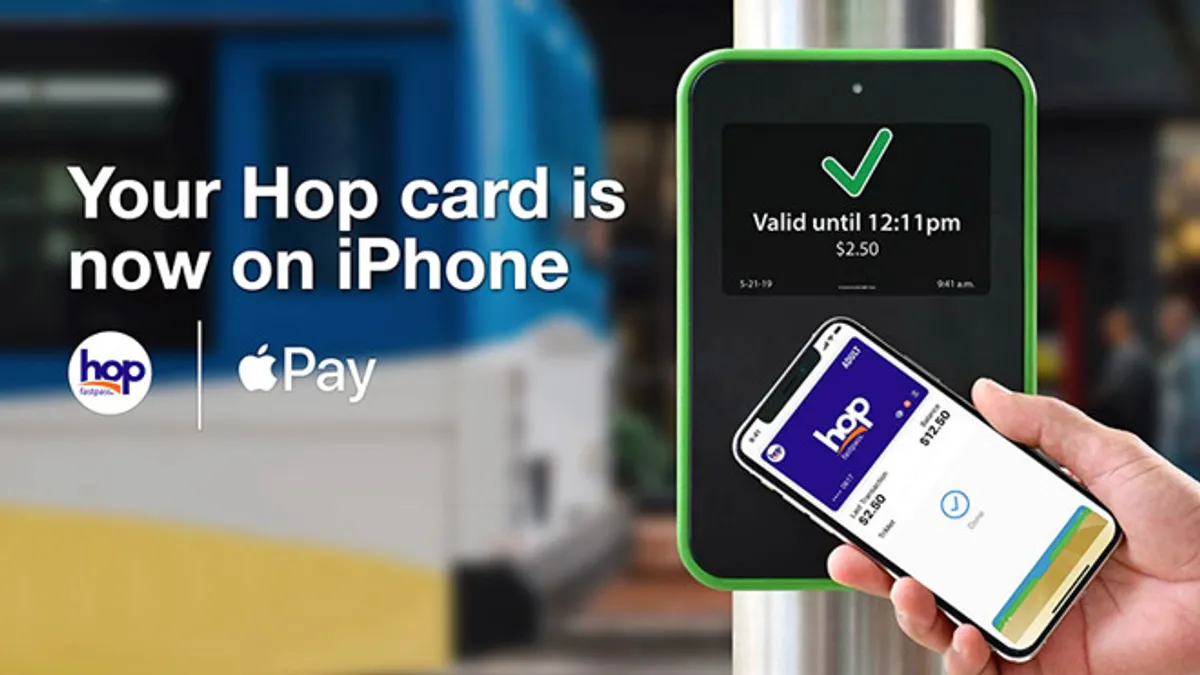UPDATED, May 23, 2019: Transit agencies in Portland, OR have announced that Hop Fastpass, the fare card for the region's TriMet, C-TRAN and Portland Streetcar transit offerings, is now integrated with Apple Pay.
This development allows riders to add the Hop Fastpass to their Apple Wallets, then tap their iPhones or Apple Watches when boarding public transit to pay the fare. Users can also reload cards or pay for rides through the Wallet app.
Portland is the first U.S. city to roll out a contactless payment system integrated with Apple Pay. Transit agencies in Chicago and New York are also gearing up for similar partnerships with Apple this year.
Dive Brief:
- During a special media event on Monday, Apple announced it will bring Apple Pay transit fare payment systems to three U.S. cities this year. The offering will first launch in Portland, OR, followed by Chicago and New York City.
- Currently, six major cities use Apple Pay in their transit systems: London, Moscow, Tokyo, Beijing, Shanghai and Guangzhou, China. Apple CEO Tim Cook said at a public unveiling that this offering has made riding transit "easier and more convenient than ever before. Every day, millions of customers in these cities use their iPhone or their Apple Watch to go quickly through the turnstiles and get on their way."
- Cook noted that Apple Pay's overall growth has been "literally off the charts," and the company looks forward to "a future where all payments are made this way." He said Apple Pay will be available for retail transactions in more than 40 countries by the end of the year.
Dive Insight:
Details around this announcement, including a specific timeline and information on which types of public transit will accept the service, are currently light. However, it fits a growing trend of cities partnering with payment solutions providers to modernize public transit offerings. Mastercard has been a leader in this space for some time now, and is rolling out a similar contactless payment option for transit in a number of U.S. cities including Dallas, Miami-Dade and New York.
Many took to Twitter to express excitement about the development, with some touting successful Apple Pay transit programs in London.
Apple Pay is coming to transit in Portland first, and then Chicago and NYC later this year. Here in London we already use Apple Pay for trains, buses, tubes, taxis, light rail, and more. Apple Pay is one of Apple's best services, it's great pic.twitter.com/x0wnUnfQxY
— Tom Warren (@tomwarren) March 25, 2019
After visiting London a few times last year, I can say the Apple Pay for transit is just fantastic. Astounding the U.S. still does not have it.
— Joseph (@JoePWilliams31) March 25, 2019
Apple Pay working on transit in New York, Portland & Chicago is the best part of today’s #AppleEvent. That feels like a LONNNGGG overdue feature. Why do I need a seperate card to catch a train? I don’t have a seperate card for ANYTHING
— Scotty McDonald (@Scotty_McDonald) March 25, 2019
However the deployment of tap-and-go payment systems come with their own set of risks and costs. While the potential of ditching a transit card may incentivize more riders to use public transit, it could also exclude riders who lack access to credit cards or smartphones. Additionally, implementing such technologically-advanced systems requires updating existing infrastructure, which can put a financial strain on already limited municipal budgets. Some cities are looking to slowly modernize their transit in multiple phases in an effort to successfully transition both the city and riders to the updated systems.
If cities are considerate of equity and rolling out such offerings in a timely and budget-friendly manner, partnering with companies like Apple could present a huge boon to public transit systems and efforts to curb congestion and carbon emissions. Considering today's ubiquity of iPhones and Apple products, it is likely Apple will quickly become a leading partner for transit fare systems in U.S. markets.












